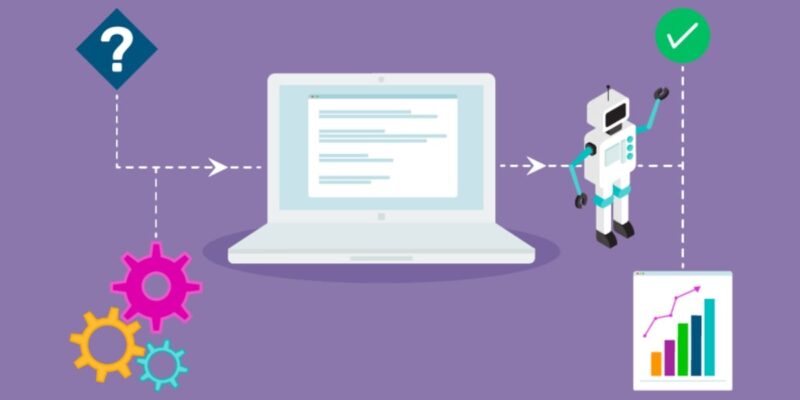
The Ultimate Guide to Workflow Automation Software in 2024
In today’s rapidly evolving business landscape, staying competitive means embracing digital transformation and optimizing operational efficiency.
Workflow automation software has emerged as a game-changer, revolutionizing how businesses manage their processes, boost productivity, and reduce manual labor.
As we navigate through 2024, the importance of these tools has only grown, with more companies recognizing their potential to drive growth and innovation.
This comprehensive guide will explore the top 10 must-have workflow automation SaaS (Software as a Service) solutions that are reshaping the way businesses operate.
We’ll delve into their features, benefits, and how they can be leveraged to streamline your workflows and propel your business forward.
Understanding Workflow Automation
Before we dive into the specific tools, let’s clarify what workflow automation entails and why it’s crucial for modern businesses.
What is Workflow Automation?
Workflow automation refers to the design, execution, and automation of processes based on workflow rules where human tasks, data, and files are routed between people or systems based on pre-defined business rules.
It’s about reducing manual intervention in recurring business processes to increase efficiency, reduce errors, and free up human resources for more strategic tasks.
Benefits of Workflow Automation
- Increased Productivity: By automating repetitive tasks, employees can focus on high-value activities that require human insight and creativity.
- Reduced Errors: Automation minimizes human error in data entry and other routine tasks.
- Improved Efficiency: Streamlined processes lead to faster completion times and reduced operational costs.
- Enhanced Collaboration: Many automation tools facilitate better communication and collaboration among team members.
- Data-Driven Decision Making: Automated processes generate valuable data that can be analyzed to inform business strategies.
- Scalability: As your business grows, automated workflows can easily scale to accommodate increased demand without a proportional increase in resources.
- Compliance and Consistency: Automated processes ensure adherence to established procedures and regulatory requirements.
Now, let’s explore the top 10 workflow automation SaaS solutions that are making waves in 2024.
Top 10 Workflow Automation SaaS Solutions for 2024
1. Zapier: The Integration Powerhouse
Zapier remains a leader in the workflow automation space, continually expanding its capabilities to meet evolving business needs.
Key Features:
- Connects over 4,000 apps and services as of 2024
- No-code automation builder for easy workflow creation
- Advanced features like multi-step zaps and custom logic
- Robust API for developers to build custom integrations
Pricing: Zapier offers a free plan for basic needs, with paid plans starting at $19.99/month for individuals and scaling up to enterprise solutions.
Best For: Businesses of all sizes looking to connect multiple applications and automate data flow between them.
2. Monday.com: Visual Workflow Management
Monday.com has evolved from a project management tool to a comprehensive work operating system with powerful automation capabilities.
Key Features:
- Intuitive, visual interface for workflow design
- Customizable automation recipes
- Built-in time tracking and resource management
- Advanced reporting and analytics dashboard
Pricing: Plans start at $10 per user per month (billed annually), with enterprise options available for larger organizations.
Best For: Teams looking for a visually appealing, customizable workflow management solution with strong collaboration features.
3. Asana: Streamlined Project and Task Automation
Asana continues to be a favorite for teams seeking to automate their project management and task workflows.
Key Features:
- Rule-based automation for task assignment and status updates
- Workflow templates for quick setup
- Advanced search and reporting capabilities
- Workload management and capacity planning tools
Pricing: Asana’s pricing starts at $13.49 per user per month (billed annually), with enterprise solutions available.
Best For: Organizations focused on project-based work and looking to automate task management and team collaboration.
4. Trello: Visual Task Management with Power-Ups
Trello’s card-based system has been enhanced with robust automation features, making it more powerful than ever.
Key Features:
- Butler automation for creating custom buttons, rules, and scheduled commands
- Board templates for quick workflow setup
- Extensive integration options through Power-Ups
- Calendar and timeline views for better project visualization
Pricing: Trello offers a free plan, with paid plans starting at $5 per user per month for small teams and scaling up to enterprise solutions.
Best For: Small to medium-sized teams looking for a flexible, visual task management tool with easy-to-use automation features.
5. Airtable: Flexible Database and Workflow Automation
Airtable has positioned itself as a versatile solution combining the power of a database with intuitive workflow automation.
Key Features:
- Customizable interfaces for different team needs
- Scripting capabilities for advanced automation
- Robust API for custom integrations
- Gantt, Calendar, and Kanban views for versatile project management
Pricing: Airtable’s pricing starts at $10 per user per month (billed annually), with enterprise options available.
Best For: Teams that need to manage and automate complex data-driven workflows and want the flexibility of a customizable database.
6. Nectain: Comprehensive Business Process Management
Nectain offers a robust platform for managing documents, processes, and workflows, catering to businesses looking for an all-in-one solution.
Key Features:
- Advanced document management with version control
- Process modeling and optimization tools
- Customizable dashboards for real-time monitoring
- Integration with popular business applications
Pricing: Nectain offers customized pricing based on business needs and scale.
Best For: Medium to large enterprises seeking a comprehensive business process management solution with strong document handling capabilities.
7. Process Street: Streamlined Process Documentation and Automation
Process Street specializes in making complex, recurring workflows easy to manage and automate.
Key Features:
- Visual process builder for creating detailed workflows
- Conditional logic for dynamic checklists
- Seamless integration with over 1000+ apps through Zapier
- Detailed analytics and reporting on process performance
Pricing: Process Street’s pricing starts at $25 per user per month (billed annually), with custom enterprise solutions available.
Best For: Businesses looking to document, standardize, and automate their operational processes, especially those in industries with strict compliance requirements.
8. Workato: Enterprise-Grade Integration and Automation
Workato has established itself as a leader in enterprise automation, offering powerful features for complex business environments.
Key Features:
- AI-powered automation suggestions
- Pre-built connectors for thousands of applications
- Real-time data synchronization across systems
- Advanced security and compliance features
Pricing: Workato’s pricing starts at $10,000 per year for small teams, with custom pricing for larger enterprises.
Best For: Large enterprises with complex integration needs and a desire for advanced, AI-driven automation capabilities.
9. Nintex: Low-Code Process Automation Platform
Nintex offers a comprehensive suite of tools for process mapping, workflow automation, and robotic process automation (RPA).
Key Features:
- Visual process mapping and documentation
- Drag-and-drop workflow designer
- Built-in RPA capabilities for desktop automation
- Strong integration with Microsoft technologies
Pricing: Nintex offers custom pricing based on organizational needs and usage.
Best For: Organizations heavily invested in the Microsoft ecosystem looking for a powerful, low-code automation platform.
10. Kissflow: No-Code Digital Workplace Platform
Kissflow provides a unified platform for automating various aspects of work, from simple tasks to complex processes.
Key Features:
- No-code app builder for custom workflow applications
- Case management capabilities for ad-hoc processes
- Built-in project management and collaboration tools
- Advanced analytics and reporting features
Pricing: Kissflow’s pricing starts at $10 per user per month, with custom plans available for larger teams.
Best For: Businesses seeking a versatile, no-code platform to digitize and automate a wide range of workplace processes.
Choosing the Right Workflow Automation Software
Selecting the ideal workflow automation solution for your business requires careful consideration of several factors:
- Ease of Use: Look for intuitive interfaces that allow non-technical users to create and modify workflows.
- Integration Capabilities: Ensure the tool can connect with your existing software ecosystem.
- Scalability: Choose a solution that can grow with your business needs.
- Customization: Consider the level of customization required for your specific workflows.
- Security and Compliance: Verify that the tool meets your industry’s security standards and compliance requirements.
- Support and Training: Evaluate the vendor’s support options and available training resources.
- Cost: Consider both the initial investment and long-term costs, including potential ROI.
Implementing Workflow Automation: Best Practices
To maximize the benefits of workflow automation, consider these best practices:
- Start Small: Begin with a pilot project to demonstrate value and gain team buy-in.
- Map Your Processes: Clearly document your current workflows before automating them.
- Involve Stakeholders: Engage team members who will be using the automated workflows in the design process.
- Prioritize High-Impact Processes: Focus on automating workflows that will deliver the most significant improvements.
- Monitor and Optimize: Regularly review automated processes and refine them for better performance.
- Provide Training: Ensure all users are properly trained on the new systems and processes.
- Stay Flexible: Be prepared to adapt your automation strategy as business needs evolve.
The Future of Workflow Automation
As we look beyond 2024, several trends are shaping the future of workflow automation:
- Artificial Intelligence and Machine Learning: Expect more AI-driven features that can predict bottlenecks and suggest optimizations.
- Hyper-Automation: The integration of multiple machine learning, packaged software, and automation tools to deliver work.
- Low-Code/No-Code Platforms: Continued growth in platforms that enable non-technical users to create complex automations.
- Internet of Things (IoT) Integration: Increased connectivity with IoT devices for more comprehensive process automation.
- Enhanced Analytics: More sophisticated data analysis tools to derive actionable insights from automated workflows.
Conclusion
Workflow automation software has become an indispensable tool for businesses aiming to thrive in the digital age. By streamlining processes, reducing errors, and freeing up human resources for more strategic tasks, these solutions offer a clear path to increased productivity and efficiency.
As we’ve explored in this guide, there’s a wide range of options available to suit different business needs and scales. Whether you’re a small startup looking to automate basic tasks or a large enterprise seeking to overhaul complex processes, there’s a workflow automation solution out there for you.
Remember, the key to successful implementation lies not just in choosing the right tool, but in carefully planning your automation strategy, involving your team, and continuously optimizing your processes. By embracing workflow automation, you’re not just keeping up with the times – you’re positioning your business for future success in an increasingly competitive landscape.
Take the time to evaluate your options, consider your specific needs, and don’t hesitate to start small. The journey to a more efficient, productive, and innovative business begins with that first automated workflow. Here’s to your success in 2024 and beyond!








